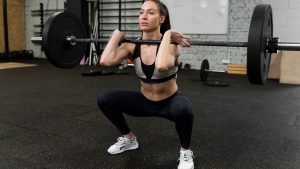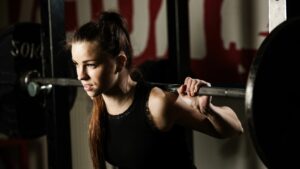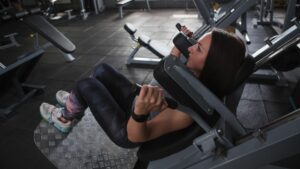Best 3 Squat Variations for Targeting Quadriceps at Home
1. Front Squats
Front squats are excellent for emphasizing the quadriceps. By shifting the weight to the front of your body, this variation places greater stress on the quads while still engaging the glutes and hamstrings.
To perform a front squat:
Hold a barbell across the front of your shoulders, keeping elbows high.
Descend into a squat, keeping your back straight and chest up.
Push through your heels to return to the starting position.

2. Narrow-Stance Squats
Narrow-stance squats, where your feet are positioned closer together than in a traditional squat, place increased emphasis on the quadriceps.
Steps for narrow-stance squats:
Stand with feet hip-width apart or slightly closer.
Lower yourself into a squat, keeping your chest up and core engaged.
Drive through your heels to stand back up.

3. Hack Squats
Though typically done on a machine, hack squats can be replicated at home using a variety of equipment like dumbbells or a barbell.
To do hack squats:
Stand with your feet shoulder-width apart.
Hold the weights behind your legs or rest a barbell behind your body.
Lower yourself by bending your knees while keeping your back straight.
Push through your heels to return to the starting position.

It’s important to note that proper form is key to targeting the quadriceps effectively and minimizing the risk of injury. Always ensure your knees track in line with your toes, and avoid excessive forward leaning or rounding of the back.
Lastly, consistency and progression are crucial. Start with a weight or resistance level that allows you to maintain proper form and gradually increase it as your strength improves.
The Importance of Quadriceps Strengthening
Developing strong quadriceps isn’t just about aesthetics; it’s integral for functional movement, injury prevention, and overall lower body strength. Whether you’re an athlete looking to improve performance or someone seeking to enhance daily activities, targeting the quads is crucial.
Why Focus on Quadriceps?
Functional Movement: The quadriceps play a pivotal role in activities like walking, running, jumping, and even standing from a seated position.
Injury Prevention: Strong quads can reduce the risk of knee injuries by providing stability and support to the knee joint.
Balanced Muscle Development: Strengthening the quadriceps in conjunction with other leg muscles promotes balanced strength, reducing the likelihood of muscle imbalances.
The Right Form Matters
Regardless of the squat variation chosen, ensuring proper form is non-negotiable. Here are some key pointers:
Knee Alignment: Keep your knees tracking in line with your toes to prevent undue stress on the knee joint.
Back Position: Maintain a straight back throughout the movement, avoiding excessive forward lean or rounding of the spine.
Depth: Aim to lower yourself until your thighs are parallel to the ground, ensuring a full range of motion without compromising form.
Engage Core Muscles: Keep your core engaged to provide stability and support during the squat.
Progression and Variation
To continually challenge your quadriceps and see improvements, it’s essential to incorporate progression and variation into your workouts:
Gradually Increase Resistance: As your strength improves, gradually increase the weight or resistance level to stimulate muscle growth.
Variety is Key: Incorporate different squat variations into your routine to prevent plateaus and engage the muscles from various angles.
Mind-Muscle Connection: Focus on consciously engaging your quadriceps throughout the movement for optimal activation.
In Conclusion
The quadriceps are a powerhouse of strength and stability for the lower body. By incorporating targeted squat variations into your home workout routine and paying attention to form, progression, and variation, you can effectively target and strengthen these crucial muscles for improved performance and reduced injury risk.
Remember, consistency is key. Regularly integrating these exercises into your routine will yield the best results over time.
Additional Resources:
Front Squat Guide by Bodybuilding.com
| Squat Variation | Key Focus | Equipment | Muscles Targeted | Key Points |
|---|---|---|---|---|
| Front Squats | Emphasizes quadriceps | Barbell or Dumbbells | Quadriceps, Glutes, Core | Places weight in front, engaging quads more. Keep elbows high for stability. |
| Narrow-Stance Squats | Targets quads with a narrow stance | None or Barbell | Quadriceps, Glutes, Hamstrings | Feet closer together emphasizes quad engagement. Maintain proper form for effectiveness. |
| Hack Squats | Targets quads using various equipment | Dumbbells, Barbell, or Machine | Quadriceps, Glutes, Hamstrings | Variation allows for quad focus using different weights and equipment. Focus on knee alignment and back posture. |
Which Variation to Choose?
Front Squats: Ideal for emphasizing quadriceps with weight positioned in front. Requires equipment but offers focused quad engagement.
Narrow-Stance Squats: Equipment-flexible and emphasizes quads with feet positioned closer together. Useful for those without access to barbells or machines.
Hack Squats: Versatile with equipment options but often done on machines. Engages quads along with other leg muscles.
Each variation has its merits, and the choice depends on personal preference, available equipment, and comfort level. Ensuring proper form and gradually increasing resistance are key for effective quadriceps targeting.
Regardless of the squat variation chosen, targeting the quadriceps through these exercises at home can significantly strengthen these crucial muscles. Consistency, proper form, and progression are essential for achieving optimal results and minimizing the risk of injury.
Wrapping up
In the realm of home workouts targeting the quadriceps, the variety of squat variations offers a rich tapestry of options. Whether you prefer the front-loaded challenge of front squats, the focused intensity of narrow-stance squats, or the versatile options of hack squats, each presents an opportunity to sculpt and strengthen those crucial thigh muscles.
Remember, the key isn’t just in the choice of exercise but in the consistency, form, and gradual progression you employ. By integrating these variations into your routine with attention to detail, you’re on the path to building stronger, more resilient quadriceps.
So, find the variation that resonates most with you, ensure your form is on point, and progress at a pace that challenges without compromising technique. Consistency paired with proper execution will undoubtedly yield the quadriceps strength you’re aiming for in your home workout journey.
Happy squatting and here’s to strong, powerful quadriceps.

Hey there, it’s Mike Rrsq, the Editor-in-Chief over at Jsquat.com, and I’m absolutely obsessed with all things squat fitness! I’ve been lucky enough to get some serious recognition for my work in this field. With a solid background in the fitness and wellness industry, I’ve been there right from the get-go, helping shape this website into what it is today.
You see, I’m not just the boss around here; I’m also a passionate contributor. I love sharing my insights through my articles, and trust me, they’re not your run-of-the-mill stuff. Each piece I write is a labor of love, filled with my expertise and real-world experience in the fitness universe. So, if you’re into fitness and looking for some inspiration, you’re in the right place!
Related Posts
- How a 33-Year-Old Can Modify Back Squat for Home Workouts
As we navigate the ever-changing landscape of fitness routines, adapting exercises for home workouts with…
- How can 16-year-old know if doing back squat correctly at home
Ensuring proper form while doing back squats, especially at home, is crucial to prevent injuries…
- Adjusting Back Squat for Home Workouts: A Guide for 17-Year-Olds
As a 17-year-old looking to maintain fitness or build strength without access to traditional gym…
- Which squat stance for quads? how and why
Hey there, fitness enthusiasts! Ready to dive into the world of squats and discover which…
- How can Ballet Squat (Plie Squat) help improve balance
The ballet squat, also known as a plié squat, is a fantastic exercise for enhancing…
- If you cant single leg squat then should you be doing a full squat
Whether or not to attempt a full squat if you can't perform a single-leg squat…
- Should female front squat harder than the back squat for glutes and tights
Front squats and back squats are both excellent exercises that engage various muscles, including the…
- Is Squat Isometric Based Exercise? (Explained)
Find out if squatting is an isometric exercise and discover the benefits of incorporating squats…
